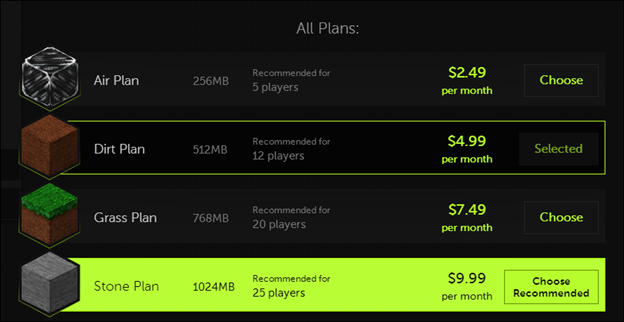Quick Links
You read over the local-host server guides, you even set up a local server (or two), but you’ve realized that your home network isn’t fast enough for you to share your server with friends. No worries, today we’re taking a peek at the world of remote Minecraft hosts.
Preparing to Pick a Host
Before we even begin to delve into the subject, the first thing we would suggest is becoming very familiar with the ins-and-outs of running the local server on your network before jumping into paying for and dealing with a remote host.
The degree of tech support offered by different hosts ranges from hand-holding to completely DIY so it really helps to know the tools you plan on using pretty well before diving into managing a remote Minecraft server.
The knowledge you’ve acquired via reading our previous Minecraft tutorials, as well as the knowledge you continue to build up by playing with the servers you’ve installed, exploring plugins, etc., will prove very useful when comparing hosts and setting up your first remote server.
Unlike previous tutorials where we guide you through an explicit step-by-step, this lesson is focused on familiarizing yourself with the basic terms used by Minecraft hosting sites, the options out there, and how to avoid getting ripped off in the process.
A final word before we begin: our advice and suggestions are based on the premise that you are a home user who wants to host a remote server so that they and their friends can more easily play. The logistics of hosting a server that will support hundreds of players is beyond the scope of this lesson.
Going the Official Route
Before we dive into the myriad of unofficial hosts out there, we need to give Minecraft Realms a big nod. It’s the only official Minecraft host in the world as it’s directly endorsed, hosted, and promoted by Mojang.
Although it doesn’t support plugins, mods, or the more advanced features such add-ons bring to servers, it does feature simple billing ($13 a month for 10 players), zero chance of getting ripped off, stable servers, great uptime, and regular world backups.
Everything that appears in the regular PC edition (mobs, biomes, infinite maps) appears in Minecraft Realms.
If you just want to play with next-to-zero setup and no headaches, Realms is a solid option. It’s official, it’s simple, and at a little over a buck a player per month, it’s cheap.
What to Look For In a Personal Minecraft Host
As we emphasized in the introduction to this lesson, the focus here is on personal hosting. While commercial-level Minecraft hosting can get pretty pricey, there’s a ton of economical hosting options for people interested in hosting a small number of friends.
Hardware Considerations
As anyone who has ever suffered through five frames per second on an old laptop can tell you, Minecraft can be a bit hardware intensive, especially if you have lot of players and mods running.
When shopping for a Minecraft host, look for hosts that have current and speedy server processors (the individual speed of the processors is more important than the multi-core abilities as Minecraft doesn’t use multi-threading).
You don’t need a lot of disk space for Minecraft, but it is a very read/write intensive game so SSDs are a bonus (most Minecraft hosts advertise that all their servers use SSDs).
Setup Considerations
How easy is it to configure the host? Most hosts have evolved to the point that they offer the sort of click-n-pay setup web hosts like GoDaddy have perfected. Take the time to read the Help/FAQ files while shopping. A good host will walk you through the setup and won’t try to stick you with a $30 fee to install Forge, Bukkit, etc.
Maintenance Considerations
Once the server is up and running you’ll need to keep it running smoothly. How does the host provide for that? Will you have a nice web-based control panel? FTP access for swapping files? Will you need to do everything via command line or do they offer graphical tools? Does the host feature Minecraft-specific controls like Multicraft, or an equivalent solution?
Reputation Considerations
There are many, many Minecraft hosts out there and just like other hosting solutions (like web hosts) the quality varies tremendously. Further, the price is typically little indication of the quality.
MCProHosting, for example, is the same host that powers some of the biggest multiplayer Minecraft servers around (like the enormous Hypixel server), yet you can pick up a barebones vanilla Minecraft server package from them perfect for a half dozen players for only $2.49 a month. Add some extra RAM to support a Bukkit installation and mods and you can still squeeze by for around $8-10 a month. You’re on the same host and network as the big boys, but you’re paying Dollar Menu prices for your little server.
Read the Minecraft forums and ask for recommendations and information about hosts you’re not familiar with.
Roll Your Own Hosting Plan
We’re including this as a point of consideration but we’ll be upfront with you, unless you have experience with hosting services, are comfortable with Linux, and are willing to do 100 percent of your own troubleshooting, a roll-your-own-plan is a tough sell. You’ll essentially be hosting a remote computer that you’re completely in charge of setting up.
That said, where the roll-you-own plan really shines is if you’re looking to host a lot of players. At the lower end (20 players or less), it makes little sense not to get a plan from a respected Minecraft host; you’ll just be paying $5-15 a month or even less if you get a tiny plan. But, as the amount of memory you require to host a server climbs, prices scale upward pretty quickly.
If you’re willing to be 100 percent responsible for everything from the set up to the maintenance to the backup routines, you can pick up virtual hosting dirt cheap from places like OVH where a server with 2GB of memory will run you $7 a month, but 2GB of RAM on a dedicated Minecraft host will run you $20-30. You can upgrade the same setup all the way to 8GB of RAM and not even break $25 a month whereas a similar setup on a Minecraft host would run you around $80.
Again, you’re completely on the hook for all the work required to set things up. Where it will take you five minutes with a proper Minecraft host to go from paying to playing, you’ll spend a weekend (or longer) tweaking a from-scratch setup on a virtual host if you go with the roll-your-own-plan.
Regardless of which solution you end up with, you know have access to a whole new world of play. A remote server is always on, always available, and your friends can login from anywhere in the world without worrying about whether or not your home connection is up (or can support everyone you've invited to play).



